Physical Address
304 North Cardinal St.
Dorchester Center, MA 02124
The anatomy of the proximal tibia involves a complex interaction between bone, ligaments and their attachment sites, cartilage, and muscles. The knee is an intricate hinge joint consisting of the tibia, femur, and patella. Ligamentous and muscular attachment sites also include the proximal fibula. Rather than being a purely rotational motion around a fixed axis, the tibiofemoral articulation involves posterior translation of the femoral condyles in relation to the tibia during flexion. This phenomenon is often termed “posterior rollback” and permits higher degrees of knee flexion by preventing impingement between the posterior tibial plateau and posterior distal femur. Additionally, when going into full knee extension, the distal femur articular surface internally rotates in relation to the tibial plateau. This is termed the “screw-home mechanism” and helps provide stability to the knee in full extension. , This occurs partly as a result of the bony anatomy in the knee, with the lateral femoral condyle being larger than the medial condyle from anterior to posterior, and the medial condyle extending further distally than the lateral condyle.
The undersurface of the patella articulates with the femur and provides additional torque for knee extension. Normal patella height is such that on a lateral x-ray with the knee in 30 degrees of flexion, the distal pole of the patella should rest at or slightly proximal to the tibiofemoral joint line. Forces transmitted across the patellofemoral joint can reach magnitudes of 3 times body weight during normal activities of daily living and can approach up to 20 times body weight during sporting activities. ,
The tibia is a long bone that is somewhat triangular in shape when viewed in an axial plane. The proximal tibia widens significantly when going proximally from the diaphysis to the metaphysis and articular surface. The articular surface ranges in width from approximately 75 to 90 mm at its maximum, and these will be common screw lengths used in fixation of tibial plateau fractures. The articular surface width of the proximal tibia closely matches or is slightly wider than the articular width of the distal femur. , The medial and lateral tibial plateau are asymmetric with the lateral plateau being slightly proximal and concave compared to the medial surface. Although it can vary among individuals, the posterior slope of the tibial articular surface in the sagittal plane is approximately 10°. Separating the medial and lateral articular surfaces of the proximal tibia are the medial and lateral tibial spines (also referred to as the intercondylar eminence). The tibial spines are two surface projections in the midline of the plateau that are points of attachment for the menisci, anteriorly as the attachment point for the anterior cruciate ligament (ACL) and posteriorly as the attachment site for the posterior cruciate ligament (PCL). The intercondylar eminence does not come into contact with the distal femur under normal loading conditions and as such is void of hyaline cartilage.
The articular surface is covered by two C-shaped rings, the medial and lateral menisci. The menisci contain attachments to the periphery of the tibial plateau through coronary (or meniscotibial) ligaments. The lateral meniscus is larger and more mobile than the medial meniscus. The menisci increase articular congruency in the knee and help to transmit load across the knee. They are made up primarily of type I collagen and have a blood supply that is greater in the periphery than in the interior of the ring. Blood supply for the menisci comes from the middle and inferior genicular arteries and from diffusion.
The proximal tibial metaphysis serves as an attachment site for several important structures ( Figs. 1.1–1.3 ). The tibial tubercle is located anteriorly in the midline of the proximal tibial metaphysis and serves as the insertion of the patellar tendon. Gerdy’s tubercle sits slightly lateral and proximal to the tibial tubercle and serves as the insertion of the iliotibial (IT) band. Halfway between Gerdy’s tubercle and the fibular head and just beyond the lateral articular margin is the attachment point of the anterolateral ligament (ALL). Avulsion fracture of this insertion is termed a “Segond fracture” and is often associated with ACL tears. The proximal medial tibial metaphysis serves as the insertion point of the pes anserinus which is the confluence of tendons of (from anterior to posterior and superficial to deep) the sartorius, gracilis, and semitendinosus. Beneath this tendon structure is the anserine bursa which can become inflamed and therefore a source of pain over the medial tibial plateau. The medial collateral ligament contains superficial and deep portions with a broad insertion from the medial meniscus and medial edge of the plateau (deep medial collateral ligament [MCL]) to the medial tibial metaphysis (superficial MCL) approximately 6 cm distal to the joint line.
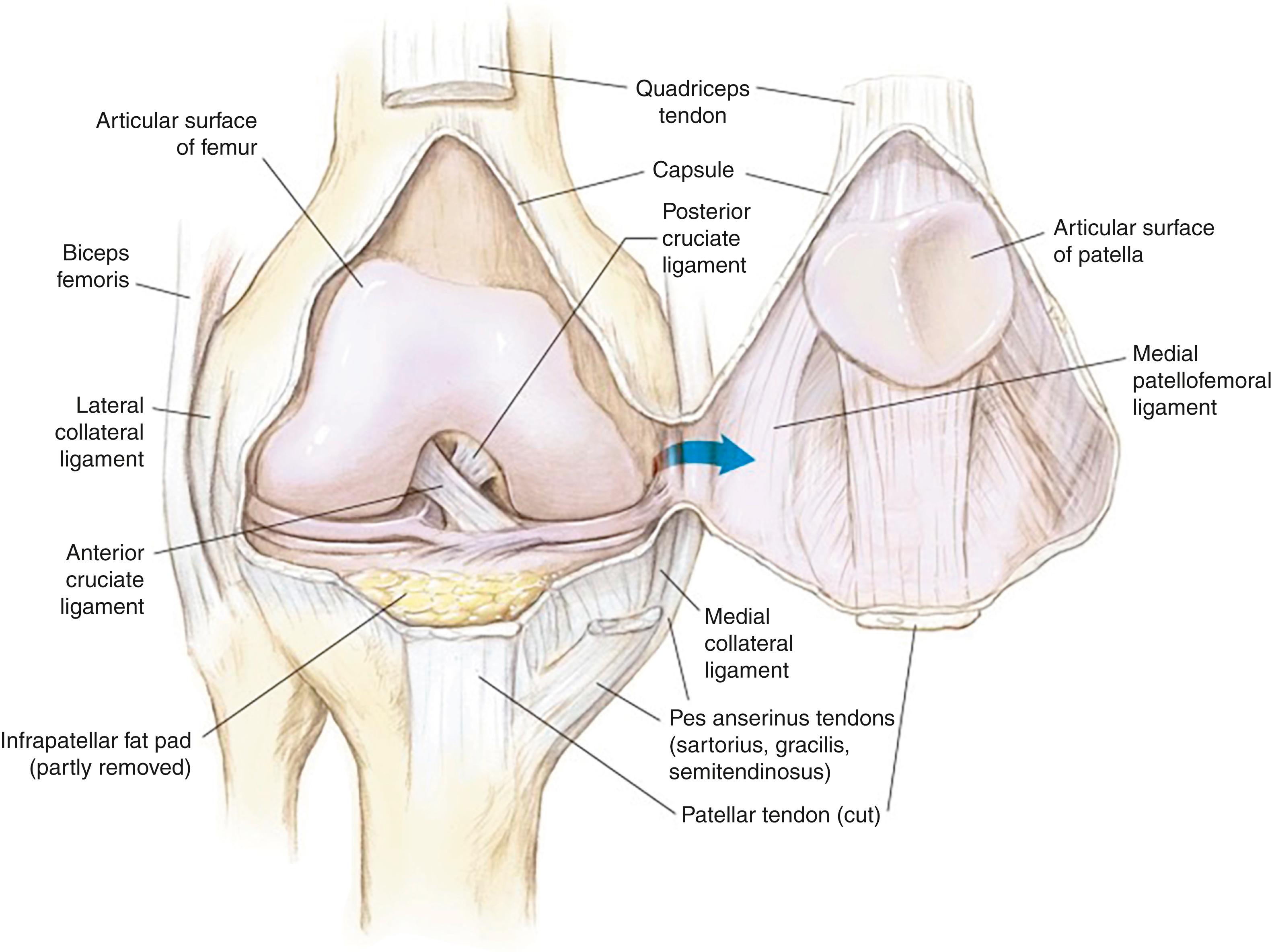
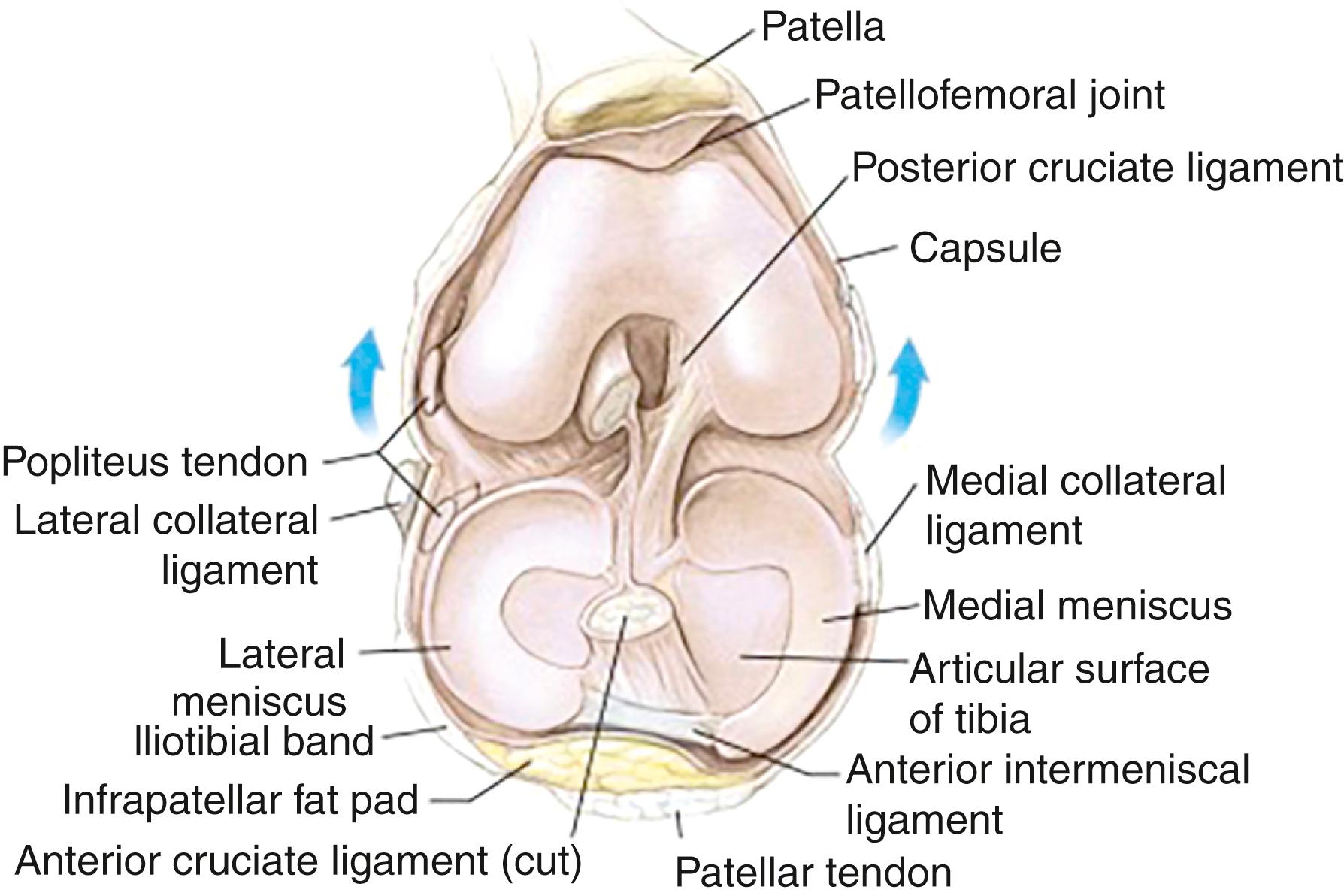
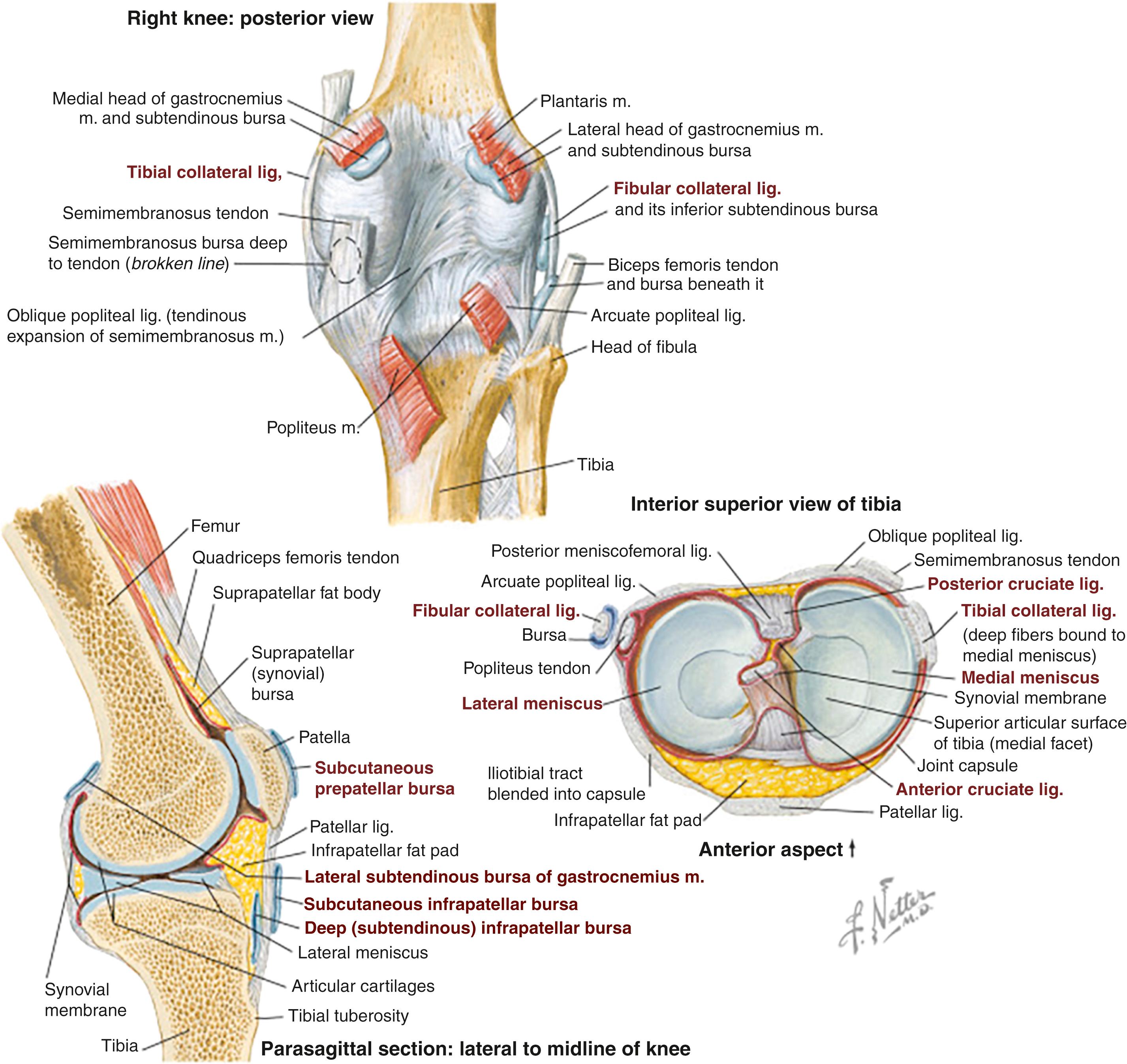
The fibula is located posterolaterally and articulates with the tibia through the proximal tibiofibular joint. This is an arthrodial joint (allows only gliding motion) at the level of the tibial metaphyseal flare. The anterior and posterior fibular head ligaments constrain this joint with the anterior ligament being broader and stronger than the posterior ligament. Also inserting on the head of the fibula are the biceps femoris tendon and lateral collateral ligament (LCL). The peroneal nerve wraps from posterior to anterior around the lateral fibular neck before dividing into superficial and deep branches.
The cruciate ligaments (ACL and PCL) prevent anterior and posterior translation of the tibia in relation to the femur. The ACL originates on the lateral femoral condyle posterior to the intercondylar ridge of the femur. It inserts into the tibial intercondylar eminence just posterior to the transverse meniscal ligament and has a variable broad insertion that can measure approximately 1.1 ×1.5 cm from medial to lateral and anteroposterior. The shape of the tibial insertion has been described in many different ways including oval, triangular, C-shaped, and “duck foot–like”. The PCL originates on the medial femoral condyle and travels between the posterior meniscofemoral ligaments (Humphrey—anterior to PCL; Wrisberg—posterior to PCL) and inserts posteriorly into the intercondylar eminence and extends distally below the articular surface. The PCL is slightly longer and larger in diameter than the ACL. Fractures involving the intercondylar eminence can be functionally equivalent to cruciate ligament tears and may require fixation.
As noted earlier, the MCL has a broad insertion on the medial tibia. It possesses an intimate relationship with the medial meniscus through direct attachments. The MCL attaches to the posterior half of the tibia when viewed in the sagittal plane. The MCL, its position, and its attachments can somewhat limit the exposure to the articular surface with medial approaches to the tibial plateau. The MCL resists valgus forces across the knee. The posterior oblique ligament (POL) contains obliquely oriented fibers that originate posterior to the MCL on the femur and fan out posteriorly inserting on the posteromedial tibia, meniscus, joint capsule, and semimembranosus tendon ( Fig. 1.4 ).
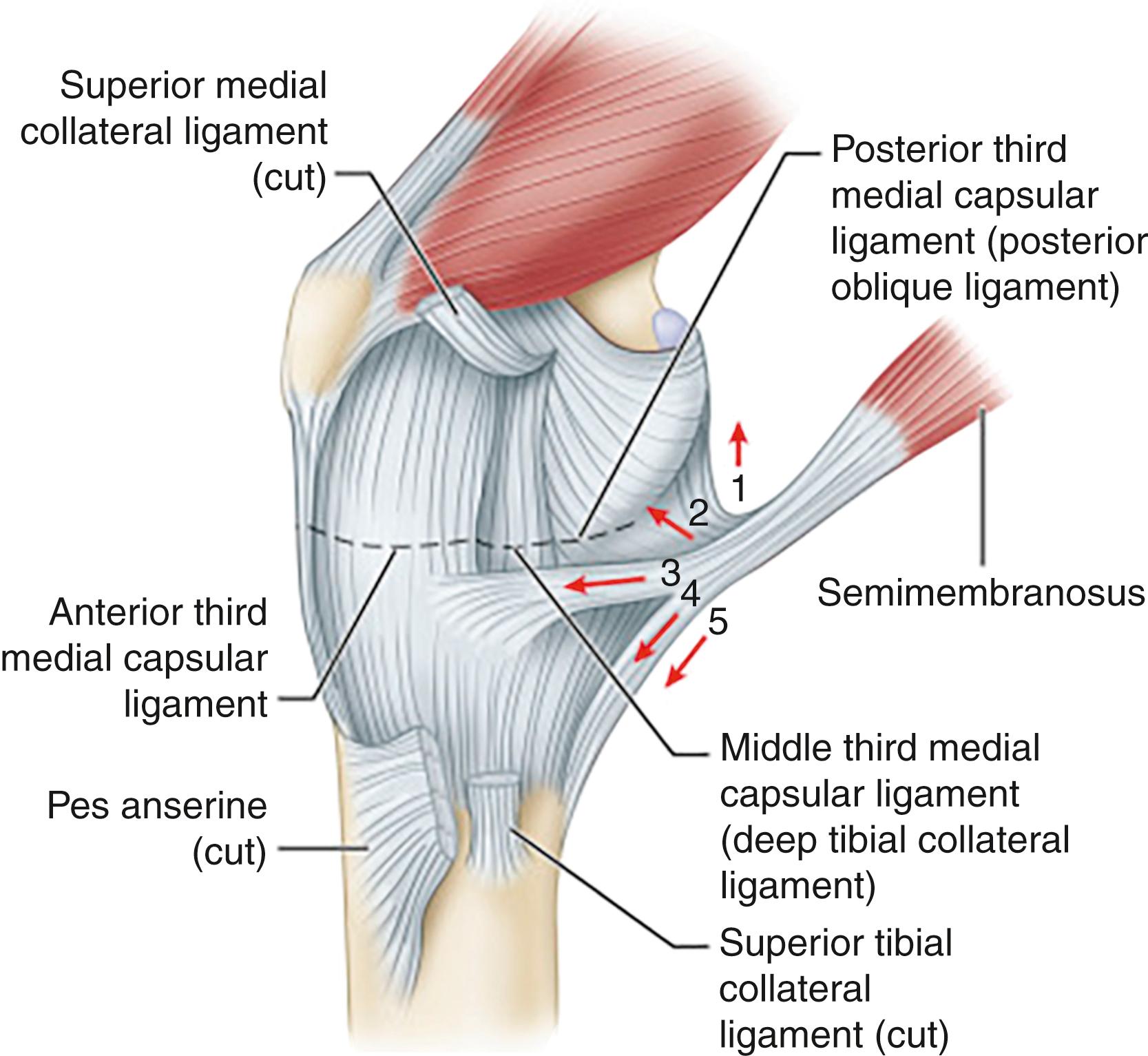
Laterally, the LCL resists varus stress at the knee. It originates roughly at or just posterior to the lateral epicondyle in a small bony depression and inserts into a small depression on the lateral fibular head 8 mm posterior to the fibular head anterior margin and 28 mm distal to the tip of the fibula. The popliteus tendon (PLT) originates approximately 18.5 mm anterior and distal to the LCL origin just posterior to the femoral articular margin. The PLT travels posterior and inferior and has a broad insertion along the posterior medial tibia. The biceps femoris also contributes to the lateral structures of the knee with attachment sites primarily on the fibular head ( Fig. 1.5 )
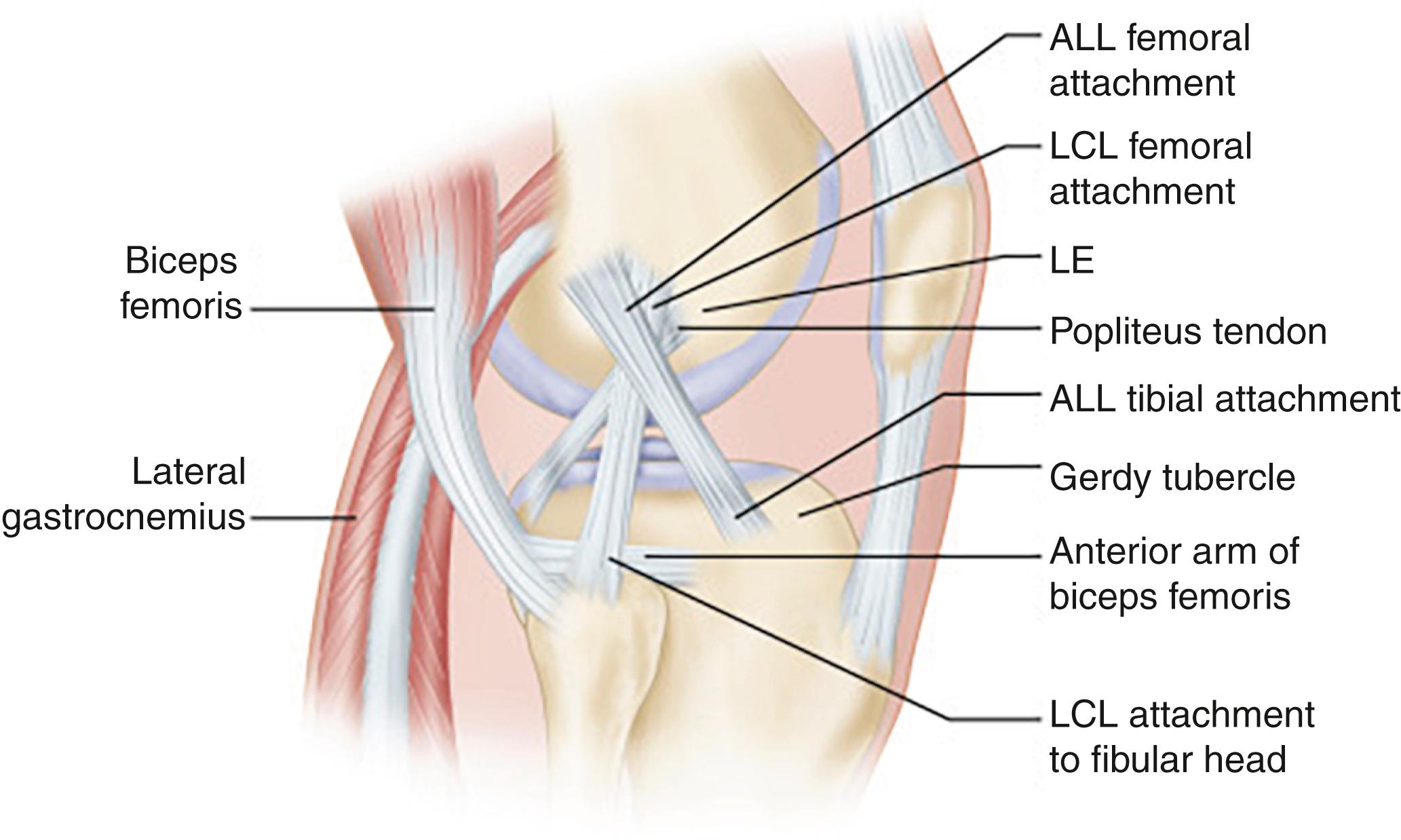
The anterolateral tibial plateau is covered by the anterior compartment musculature of the lower leg. These muscles are elevated in order to gain access to the proximal tibia for reduction and placement of plate fixation. Posteriorly, the gastrocnemius muscle originates from the medial and lateral femoral condyles. Deep to the gastrocnemius and arising from the posterior tibia and posterior fibular head is the soleus muscle. From medial to lateral, the popliteal artery, vein, and tibial nerve travel through the popliteal space and dive deep to the soleus arch before giving off additional branches. Geniculate arteries branch off of the popliteal artery prior to entering the soleus arch and provide blood supply to the knee. The saphenous vein and nerve travel subcutaneously along the medial side of the knee and can be injured during medial approaches ( Fig. 1.6 ).
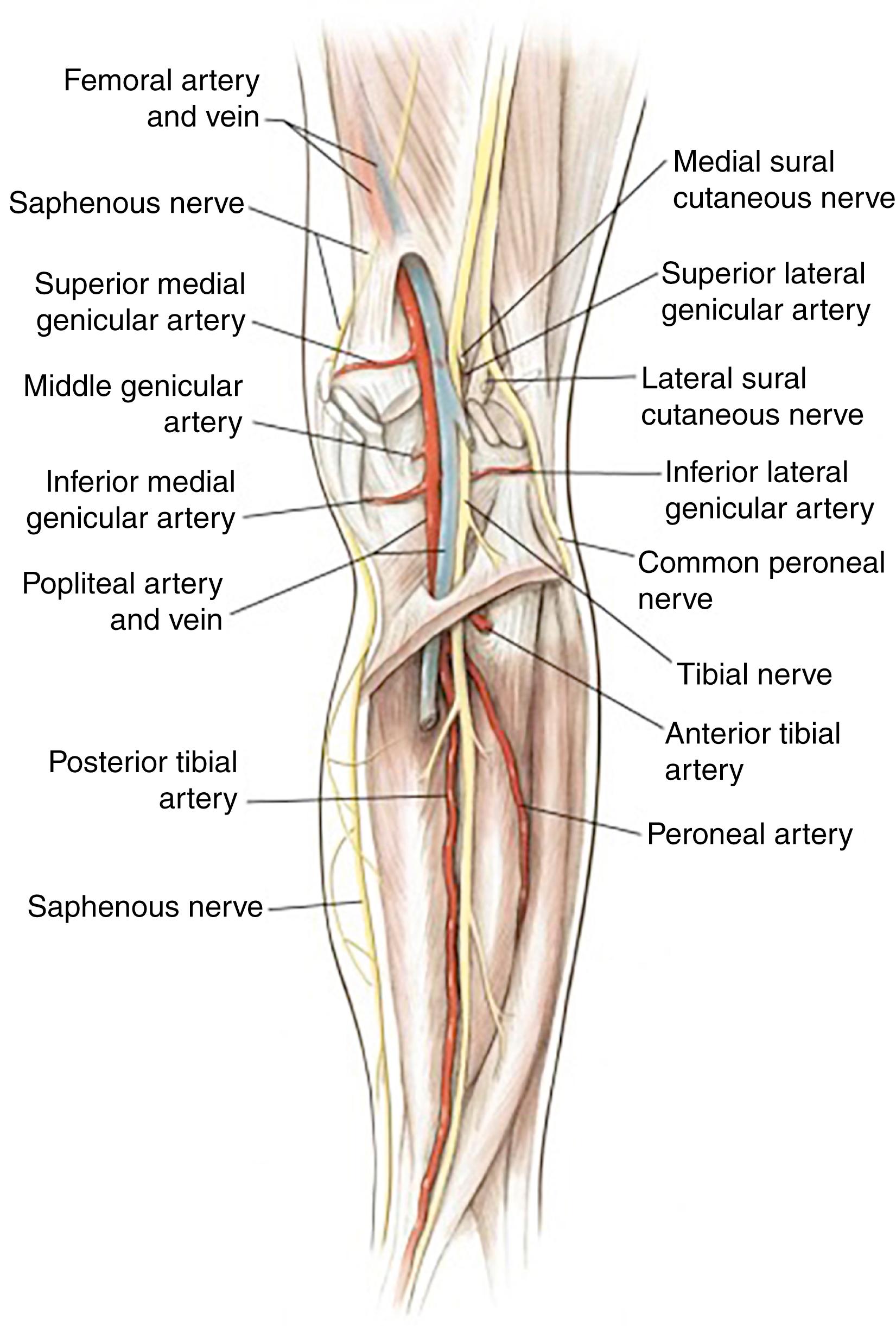
The following approaches can be performed with or without a tourniquet placed high on the thigh. It is the author’s preference to apply a tourniquet in all cases but to leave the tourniquet deflated during exposure in most cases, inflating only if necessary to visualize joint reduction. With prone approaches, it is helpful to apply the tourniquet with the patient supine prior to flipping prone. In all approaches, padding of bony prominences is advised. In supine approaches, where hip internal rotation is desired, a bump is placed under the ipsilateral hip and the ipsilateral arm is often brought over the chest and secured rather than being placed abducted on an armboard. It is the author’s preference to prewash the entire extremity with a scrub brush followed by alcohol, then to prep and drape the leg from the tourniquet to the toes, and to apply a second prep after draping. The vast majority of tibial plateau fractures can be exposed and treated with the use of one or both of the first two approaches described here, anterolateral and posteromedial.
Become a Clinical Tree membership for Full access and enjoy Unlimited articles
If you are a member. Log in here